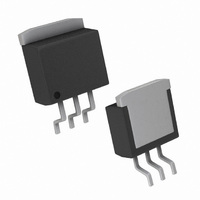LM2937ES-3.3/NOPB National Semiconductor, LM2937ES-3.3/NOPB Datasheet - Page 8

LM2937ES-3.3/NOPB
Manufacturer Part Number
LM2937ES-3.3/NOPB
Description
IC REGULATOR LDO TO-263
Manufacturer
National Semiconductor
Datasheet
1.LM2937IMP-3.3NOPB.pdf
(11 pages)
Specifications of LM2937ES-3.3/NOPB
Regulator Topology
Positive Fixed
Voltage - Output
3.3V
Voltage - Input
Up to 26V
Voltage - Dropout (typical)
0.11V @ 50mA
Number Of Regulators
1
Current - Output
500mA
Operating Temperature
-40°C ~ 125°C
Mounting Type
Surface Mount
Package / Case
TO-263-3, D²Pak (3 leads + Tab), TO-263AA
Number Of Outputs
1
Polarity
Positive
Input Voltage Max
26 V
Output Voltage
3.3 V
Output Type
Fixed
Output Current
0.5 A
Line Regulation
9.9 mV
Load Regulation
3.3 mV
Voltage Regulation Accuracy
+/- 5 %
Maximum Operating Temperature
+ 125 C
Mounting Style
SMD/SMT
Minimum Operating Temperature
- 40 C
Lead Free Status / RoHS Status
Lead free / RoHS Compliant
Current - Limit (min)
-
Lead Free Status / Rohs Status
Details
Other names
*LM2937ES-3.3
*LM2937ES-3.3/NOPB
LM2937ES-3.3
*LM2937ES-3.3/NOPB
LM2937ES-3.3
Available stocks
Company
Part Number
Manufacturer
Quantity
Price
Part Number:
LM2937ES-3.3/NOPB
Manufacturer:
TI/德州仪器
Quantity:
20 000
www.national.com
Application Hints
EXTERNAL CAPACITORS
The output capacitor is critical to maintaining regulator sta-
bility, and must meet the required conditions for both ESR
(Equivalent Series Resistance) and minimum amount of ca-
pacitance.
MINIMUM CAPACITANCE:
The minimum output capacitance required to maintain sta-
bility is 10 µF (this value may be increased without limit).
Larger values of output capacitance will give improved tran-
sient response.
ESR LIMITS:
The ESR of the output capacitor will cause loop instability if
it is too high or too low. The acceptable range of ESR plotted
versus load current is shown in the graph below. It is essen-
tial that the output capacitor meet these requirements,
or oscillations can result.
It is important to note that for most capacitors, ESR is
specified only at room temperature. However, the designer
must ensure that the ESR will stay inside the limits shown
over the entire operating temperature range for the design.
For aluminum electrolytic capacitors, ESR will increase by
about 30X as the temperature is reduced from 25˚C to
−40˚C. This type of capacitor is not well-suited for low tem-
perature operation.
Solid tantalum capacitors have a more stable ESR over
temperature, but are more expensive than aluminum elec-
trolytics. A cost-effective approach sometimes used is to
parallel an aluminum electrolytic with a solid Tantalum, with
the total capacitance split about 75/25% with the Aluminum
being the larger value.
If two capacitors are paralleled, the effective ESR is the
parallel of the two individual values. The “flatter” ESR of the
Tantalum will keep the effective ESR from rising as quickly at
low temperatures.
HEATSINKING
A heatsink may be required depending on the maximum
power dissipation and maximum ambient temperature of the
application. Under all possible operating conditions, the junc-
tion temperature must be within the range specified under
Absolute Maximum Ratings.
To determine if a heatsink is required, the power dissipated
by the regulator, P
Output Capacitor ESR
FIGURE 1. ESR Limits
D
, must be calculated.
10011317
8
The figure below shows the voltages and currents which are
present in the circuit, as well as the formula for calculating
the power dissipated in the regulator:
I
P
The next parameter which must be calculated is the maxi-
mum allowable temperature rise, T
lated by using the formula:
where: T
Using the calculated values for T
mum allowable value for the junction-to-ambient thermal
resistance, θ
IMPORTANT: If the maximum allowable value for θ
found to be ≥ 53˚C/W for the TO-220 package, ≥ 80˚C/W for
the TO-263 package, or ≥174˚C/W for the SOT-223 pack-
age, no heatsink is needed since the package alone will
dissipate enough heat to satisfy these requirements.
If the calculated value for θ
heatsink is required.
HEATSINKING TO-220 PACKAGE PARTS
The TO-220 can be attached to a typical heatsink, or se-
cured to a copper plane on a PC board. If a copper plane is
to be used, the values of θ
the next section for the TO-263.
If a manufactured heatsink is to be selected, the value of
heatsink-to-ambient thermal resistance, θ
calculated:
Where: θ
IN
D
= I
= (V
L
÷ I
IN
T
θ
(C−H)
G
− V
A
J
(J−C)
FIGURE 2. Power Dissipation Diagram
(max) is the maximum ambient temperature
(max) is the maximum allowable junction tem-
OUT
(J−A)
) I
T
θ
is defined as the thermal resistance from the
junction to the surface of the case. A value of
3˚C/W can be assumed for θ
calculation.
is defined as the thermal resistance between
the case and the surface of the heatsink. The
value of θ
about 2.5˚C/W (depending on method of at-
tachment, insulator, etc.). If the exact value is
unknown, 2˚C/W should be assumed for
θ
R
(H−A)
L
(C−H)
+ (V
, can now be found:
(max) = T
perature, which is 125˚C for commercial
grade parts.
which
application.
θ
IN
(J−A)
.
= θ
) I
G
(J−A)
(C−H)
= T
will
(J−A)
J
(max) − T
(J−A)
R
− θ
will vary from about 1.5˚C/W to
(max)/P
will be the same as shown in
be
(C−H)
falls below these limits, a
R
(max) and P
R
encountered
− θ
A
(max). This is calcu-
D
(max)
(J−C)
(H−A)
, must first be
(J−C)
D
, the maxi-
10011319
in
for this
(J−A)
the
is













